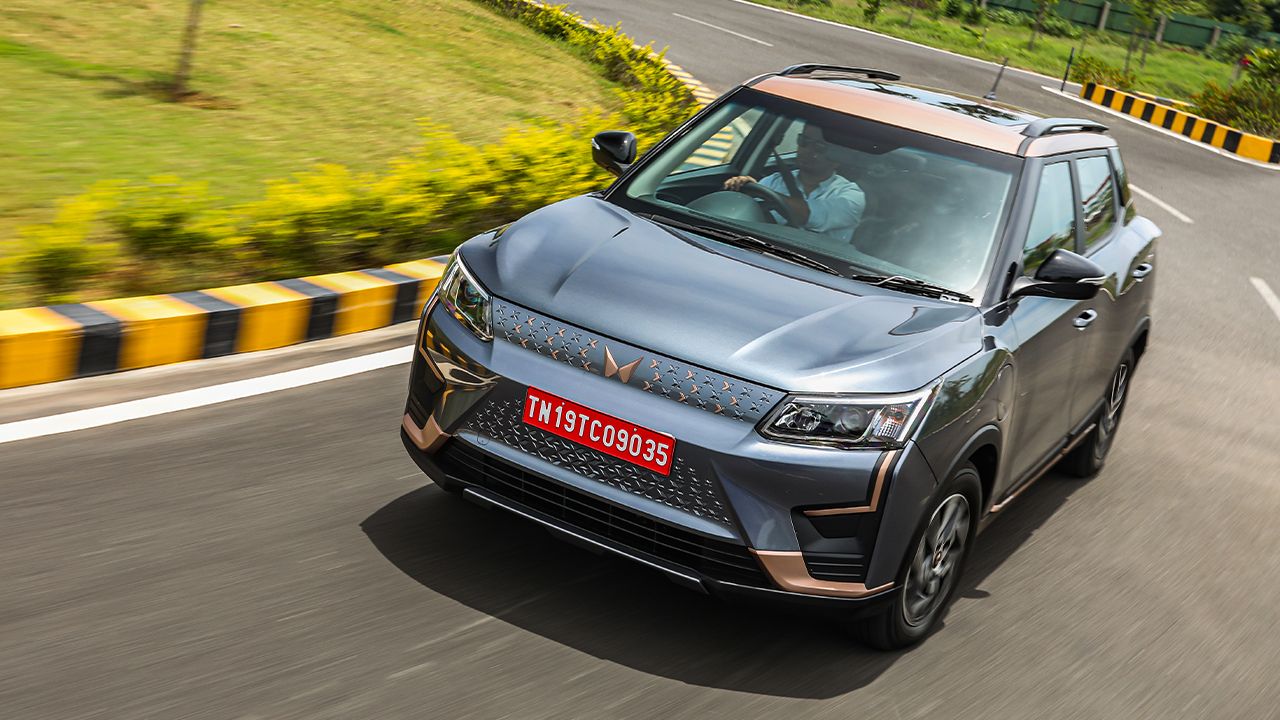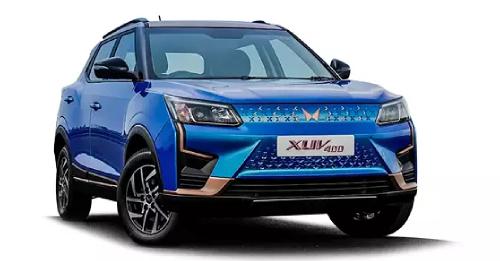We get behind the wheel of Mahindra's first-ever electric SUV – the XUV400. Does it live up to the hype, or is it too little too late for this EV?
It’s been a long time coming, but Mahindra has finally gotten its first-ever electric SUV rolling off the production floor. And it's none other than the much-anticipated Mahindra XUV400 – a longer, greener, cleaner, and much, much quieter alternative to your regular XUV300 petrol and diesel versions.
The problem is that it took Mahindra an awful lot of time to enter the EV space in India, and during this time, rivals, such as Tata, MG, and even Hyundai, have established themselves as the go-to carmakers for mass-market EVs. However, Mahindra seems to have done its homework properly, and the company is quite confident that it will make up for the lost ground with this product. So, does the XUV400 have what it takes to be the country’s next best-selling electric SUV? Let’s find out.
A Long Leash
The XUV400 is based on the same platform as the XUV300, although it’s been heavily reworked to fit the battery pack and the motor. On the surface, however, not much has changed. The overall design, silhouette, and wheelbase are identical to those of the XUV300 (2,600mm). That said, there are some crucial changes – for instance, the EV is 4.2-metres long as opposed to 4 metres of its ICE counterpart. And that’s because EVs, unlike regular petrol/diesel cars, don’t have to stick to the country’s sub-4m excise duty regulations to get tax benefits.
Now, it’s not that Mahindra made the effort to stretch the XUV300 by 200mm to turn it into the XUV400. It’s just that they’ve gone back to the original size of the SsangYong Tivoli – the compact SUV, which was chopped off at the rear and rebadged as the XUV300 for the Indian market.
Apart from its longer rear overhang, a couple of more bits differentiate the 400 from the 300. There’s no radiator grille (or radiator for that matter) – the area is simply blanked off. There’s Mahindra’s new logo, along with a heavy dose of satin copper on the front and elsewhere on the vehicle's exterior. In fact, all logos are finished in the same colour – it will be a signature item on all Mahindra EVs going forward. The top-end variant that we tested also came with a dual-tone finish, with the roof finished in the same shade of reddish brown. Mahindra will offer this EV in five colours – Arctic Blue, Everest White, Galaxy Grey, Napoli Black, and Infinity Blue. All paint options were on display during the drive, and while some looked a little cheesy, the others, like the Galaxy Grey you see here in the pictures, looked a little restrained and understated. I’m guessing Mahindra will offer lower variants with less copper detailing, which should be even easier on the eyes.
The headlamps are identical to those of the XUV300 – featuring DRLs, projector lamp for low beam, and halogen for high beam – and so are the taillamps, although they have been re-profiled slightly. The 16-inch alloy wheels on our test car had the same design as that of the ICE version. Overall, it’s not a remarkable design makeover, but the XUV400 looks contemporary. Plus, the fact that it’s longer than the 300 makes it look more proportionate for sure.
Familiar Affair
Like the exterior, the cabin of the XUV400 is a familiar affair. The dashboard design and overall layout are similar to the 300, but compared to its black-grey theme, the EV’s interior is an all-black affair, with copper accents on the aircon vents and volume and aircon controllers. There’s also a new gear selector, which looks quite upmarket. The 7-inch touchscreen is identical to what you get in the new Scorpio-N and Thar, and it gets wired Apple CarPlay and Android Auto connectivity along with over-the-air updates. Top-end variant comes with dual-zone air-conditioning, cruise control, driving modes, an electric sunroof, six airbags, rain-sensing wipers, and more. What’s missing? The steering is only rake-adjustable, and there are no ventilated front seats and a Type-C USB port (still gets a regular Type-A USB port). Plus, you also don’t get an auto-dimming IRVM. The instrument cluster is identical to that of the XUV300, but instead of the tach, you get an EV performance dial, which shows you the amount of power you’re drawing in different driving conditions. There’s a digital MID in between the dials, however, for some reason, it doesn’t show the range in default mode.
The quality and fit-and-finish are acceptable but not class-leading. There are still a lot of hard plastics all over the cabin, and the paint quality on some panels is questionable. The leather-wrapped steering wheel and the 400’s wide and cushy leatherette seats give the cabin an upmarket feel, though. The seats are comfortable and supportive, both at the front and rear. There’s no transmission hump in the middle of the rear bench, which means three passengers can sit upright and be comfortable. And thanks to those 200mm extra at the rear, the boot is now a size bigger than it is in the 300 (378 litres vs 265 litres).
Bolt-on Volts
The XUV400 isn’t a part of Mahindra’s recently unveiled Born Electric/INGLO range, meaning it’ll be a bit of a stop-gap arrangement till the time the company’s more premium offerings come on the market. This also means that it’s not based on an all-new electric architecture. And like I mentioned above, it’s the XUV300’s chassis that’s gone under the knife to accommodate the 400’s 39.5kWh battery pack and 110kW (147.5bhp/310Nm) rated electric motor. The battery pack is placed low under the floor, whereas the motor sits in the engine bay, meaning the 400 is a front-wheel drive car like its ICE counterparts.
We got to drive the XUV400 at Mahindra’s SUV testing facility near Chennai for a brief period of time, but it was enough to form our first impressions.
Our test drive began at the plant’s high-speed test track, where we had the opportunity to max out the XUV400. ‘Don’t go over 120km/h, please.’ – said the instructor on the walkie. Two minutes later, I was doing 140km/h (speedo indicated) on the very first banking on the track. And I wasn’t trying to be a rebel – the numbers just came up so effortlessly on the speedo that it felt like a walk in the park for the XUV400. Mahindra claims a 0 – 100km/h time of 8.3 seconds, and while we didn’t get to verify it during the test, it definitely accelerates briskly. Torque is transferred to the wheels instantaneously, and there’s absolutely no drama, whatsoever. The ESC keeps the wheels from spinning, and the traction is rather impressive. There are three driving modes – Fun (least fun, actually, but more range), Fast (lives up to its name), and Fearless (full send). In Fun, the throttle response is rather muted, and the top speed is limited to around 95km/h. The Fast mode feels more natural to your inputs, although top speed is limited to around 125 – 130km/h. The Fearless mode is the no-holds-barred setting, so you get max acceleration and a speedo indicated 160km/h. Mahindra says the true top speed is 150km/h. What’s remarkable here is the high-speed stability. Be it on the banking or the straight, the XUV400 stayed glued to the tarmac at speeds well over 120km/h.
The steering feels a little vague and lifeless, though. At high speeds, it’s well weighted, but since this is now a much lighter car at the front (remember, no engine?), the nose feels floaty, and you can’t really sense what the front wheels are up to. That said, the lack of weight at the front makes it nimbler around tight corners as compared to its petrol/diesel counterpart. However, if you put the power down in the middle of a corner, the instantaneous supply of torque, tall ride height, soft suspension, and lack of weight on the front axle result in loss of grip and a bucketload of understeer, resulting in you going way off of the desired trajectory. The trick to keeping all of this in check is to go a little slower, modulate the throttle, and be in 'Fun' mode instead of 'Fearless'.
As for the ride quality, we didn’t really get to test it in real-world conditions. But going over some big speed breakers at the testing facility, it was evident that the suspension is tuned for comfort and is quite absorbent. It doesn’t feel jittery or bouncy – it’s rather well damped for an EV.
What leaves wanting more is the brakes. They come with built-in regen, and you can drive the car with just one pedal as well. However, the brake pedal has an inconsistent feel, and despite featuring disc brakes on all four wheels, the braking performance isn’t as strong as you’d like in a vehicle this heavy and quick.
Range and Charging
Mahindra claims that the XUV400 can do 456km on a single charge, which is slightly more than the Nexon EV Max’s claimed range of 437km. In the real world, expect the car to return a range of close to 320 – 350km on a normal day. As for the charging time, using a 50kW DC fast charger, you can juice up the battery pack to 80% in just 50 minutes, while a 7.2kW charger will take six and a half hours to fully charge the battery. At home, using a 3.3kW AC charger, the charging time will be 13 hours. Mahindra hasn’t announced the warranty details on the battery pack as of now, but the company claims it’ll be ‘aggressive’ and on a par with rivals. So, you can expect a warranty of six to seven years on the battery pack.
Verdict
The XUV400 is a little late to the mass-market EV party, but you can’t also deny that it packs all the right ingredients, for it definitely has the measure of its rivals – Tata Nexon EV and MG ZS EV, primarily – in terms of range, performance, handling, ride comfort, features, and equipment. Pricing will be the key as always, but going by Mahindra’s past few launches, they’re likely to get it spot-on yet again.
What is going to be a bit of a hurdle is the waiting time. You see, Mahindra will launch the XUV400 in January 2023 and bookings will also start around the same time. That’s around 4 months from now. Plus, at that time, you will have even longer queues for bookings and delivery time will be further delayed (ask XUV700/Scorpio-N buyers). All in all, taking your first Mahindra electric SUV home could well take over six months from now. And, in a world where tech changes at the drop of a hat, it'll be interesting to see if the XUV400 can remain as alluring next year as it looks today.

- Mahindra XUV400
Motor: Single Motor
Battery: 39.5kWh Li-ion
Transmission: Single-Speed / Front-Wheel Drive
Peak Power: 147.5bhp
Peak Torque: 310Nm
Range: 456kms (claimed)
Expected Price: ₹17 – 20 Lakh (Ex-Showroom)
X-Factor: Mahindra's first electric SUV ticks all the boxes in terms of range, performance, ride & handling, and driving dynamics.
| Pros | Cons |
Also read,



























Write your Comment